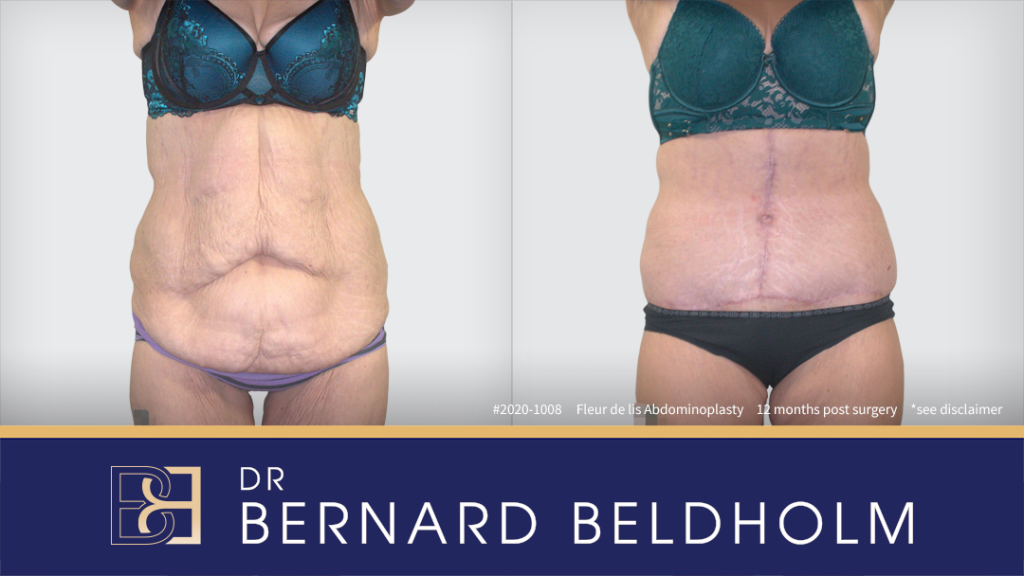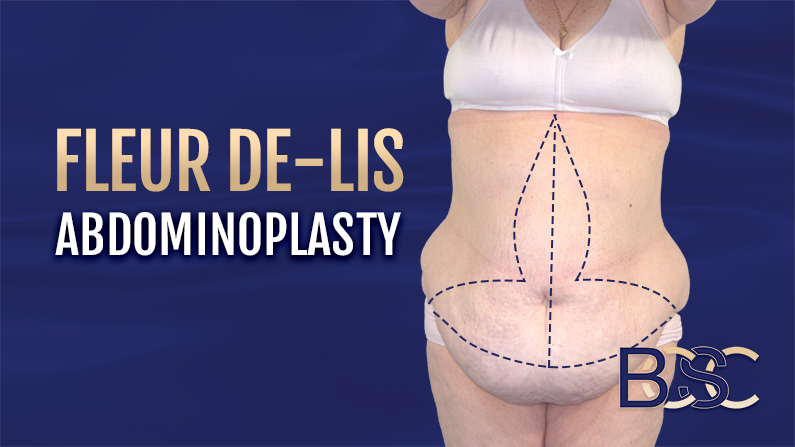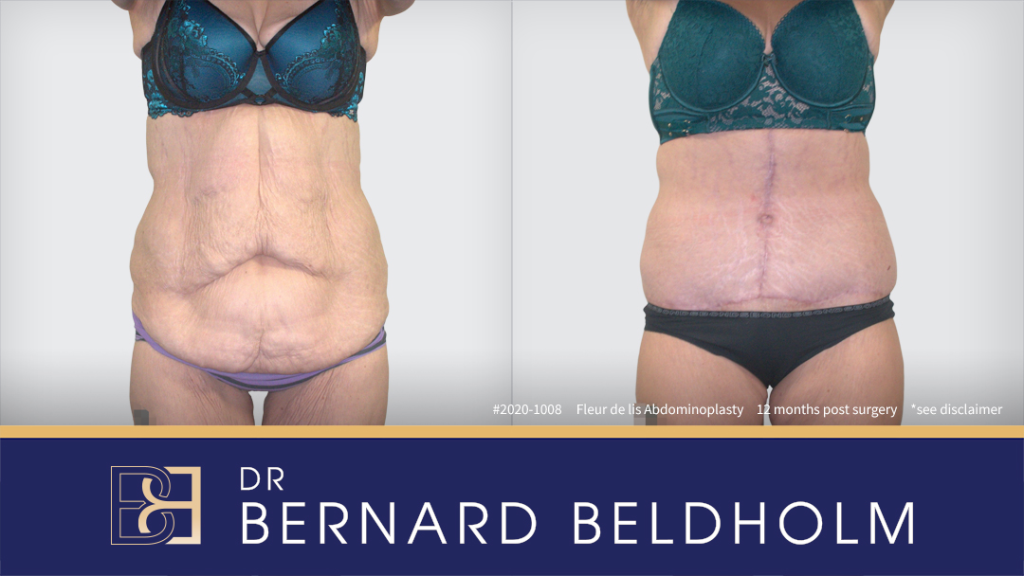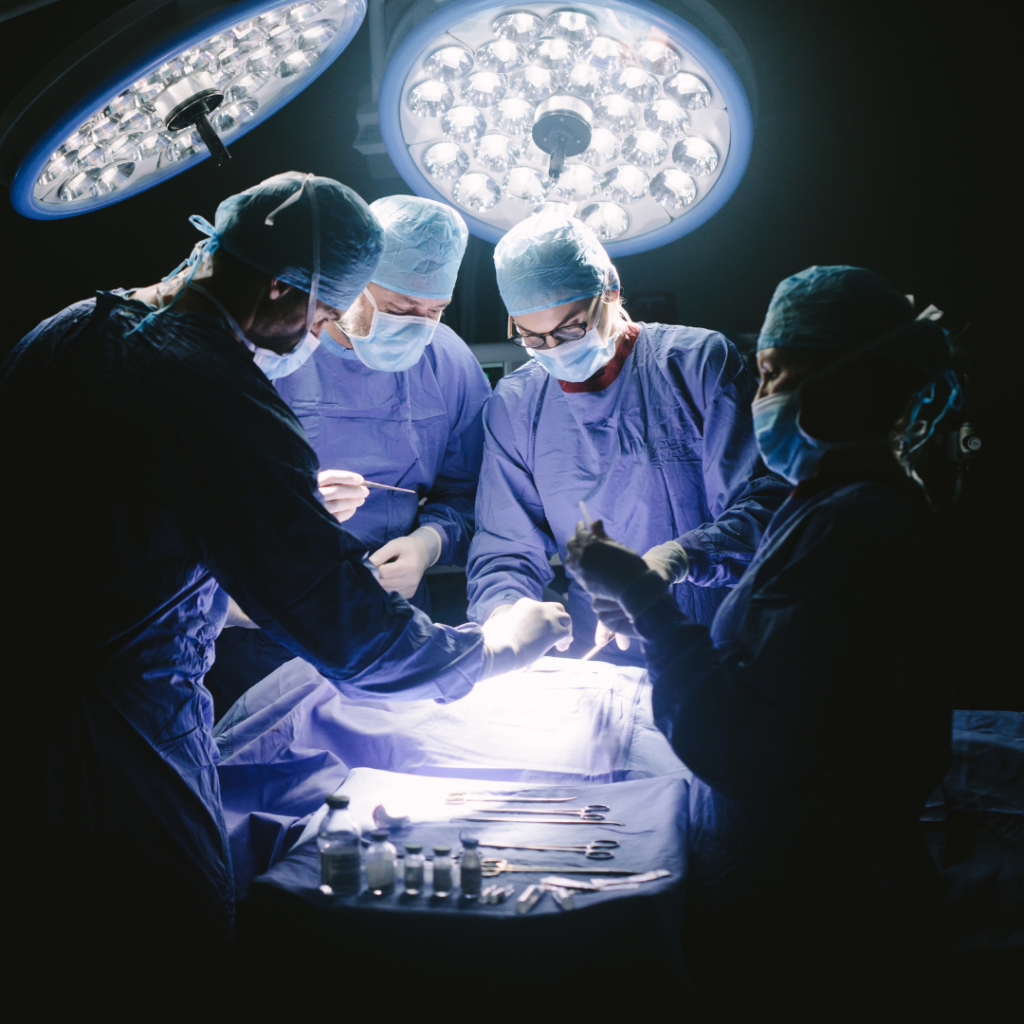What is Fleur-de-Lis Abdominoplasty?
Traditional abdominoplasty may be inadequate in ** the abdominal contours in major weight loss patients. This requires a specialised abdominoplasty procedure that adequately ** this challenge.
Fleur-de-Lis is an abdominoplasty technique that removes significant redundant belly skin and fat vertically and horizontally in major weight loss patients.
If you have had massive weight loss resulting in redundant excess abdominal skin in the upper belly as well as the lower abdominal wall, you may be a candidate for a Fleur-de-Lis abdominoplasty. But what exactly is Fleur-de-Lis abdominoplasty? This guide looks at the technique, how it differs from traditional abdominoplasty techniques, the risks, expectations after surgery, cost, and suitability.

Disclaimer: Operation performed by Dr Bernard Beldholm. Adult content, surgery has risks; individual results vary, seek 2nd opinion. Please see the full disclaimer.
Understanding Fleur-de-Lis Abdominoplasty
Fleur-de-Lis is otherwise known as Fleur de Lys abdominoplasty. Alternatively, its medical term is corset lipectomy or vertical abdominoplasty. The procedure is more extensive and complex than traditional tummy tuck procedures. This is because it ** excess abdominal skin, unlike standard abdominoplasty.
The procedure results in two scars, one horizontally on the lower abdomen and another vertically on the mid-abdomen. This allows the doctor to remove significant fatty tissue and skin in the lower and upper abdomen and ** abdominal muscle separation. The resulting scar appears as an upside-down letter T.
Fleur-de-Lis abdominoplasty derives its name from the incision pattern, which resembles an iris flower when partially closed. Fleur-de-Lis means “flower of the lily” in French.

Fleur de lis (french water lilly)
Who is a Good Candidate for Fleur-de-Lis Abdominoplasty?
Fleur-de-Lis abdominoplasty suits both females and males with significant excess skin around the abdominal region. This can be a result of massive weight loss, gastric bypass surgery, bariatric surgery, age, or other factors resulting in ** abdominal skin.

Summary of requirements to be a fleur-de-lis abdominoplasty candidate.
- Person has excessive skin on the lower and upper abdomen (both horizontally and vertically) that a standard abdominoplasty cannot **.
- Patient has attained their ideal weight, maintains a healthy lifestyle, and their weight loss has been stable for a minimum of six months.
- Person has undergone bariatric surgery or has lost the weight with medications or dieting
- Patient is in good overall health with no underlying health conditions.
- Patient has realistic expectations and understands the surgical risks.
- Patient is not considering fleur de lis surgery for ** weight loss.
- Person doesn’t smoke or is ready to quit a few weeks before surgery and after surgery (around six weeks before and after.)
While this will offer a guide, patients need a consultation with a specialist surgeon to determine whether they are good candidate for Fleur-de-Lis abdominoplasty. This will also allow the specialist surgeon to assess your general health and inform you of the potential complications and risks.
Who is a Not Good Candidate for Fleur-de-Lis Abdominoplasty?
Fleur-de-Lis abdominoplasty is unsuitable for women or men who haven’t attained a stable weight after a significant weight loss or those undergoing abdominoplasty as a substitute for weight loss. The procedure is unsuitable for patients with unrealistic expectations, underlying medical conditions, or those who smoke and are unwilling to quit.

Fleur de Lis Surgery
Traditional Abdominoplasty vs. Fleur-de-Lis Abdominoplasty
Abdominoplasty procedures include mini abdominoplasty, full abdominoplasty, extended abdominoplasty, circumferential abdominoplasty, and Fleur-de-Lis, with or without liposuction.
A Fleur-de-lis abdominoplasty is an invasive surgery and has many similarities to traditional abdominal surgeries, but there are some vast differences. While an abdominoplasty procedure is for patients requiring extensive amounts of fat and skin removal around the lower belly, fleur-de-lis abdominoplasty focuses on lower and upper abdomen (both horizontally and vertically) that a standard abdominoplasty cannot **.
The choice between getting an extended abdominoplasty or a Fleur-de-Lis abdominoplasty depends on the scope of contouring the patient needs.
Fleur-de-Lis abdominoplasty is more prevalent in post-bariatric patients with major weight loss.
Choosing between the different abdominoplasties, especially the standard abdominoplasty procedures and Fleur-de-Lis abdominoplasty, can be challenging. The choice depends on the amount of excess skin and fat being removed, previous scars, stretch marks, muscle separation, and whether the excess abdominal skin is located only horizontally, or both horizontally and vertically.
So, What Are the Key Differences Between Standard Abdominoplasties and Fleur-de-Lis Abdominoplasty?
The Incision

Disclaimer: Operation performed by Dr Bernard Beldholm. Adult content, surgery has risks; individual results vary, seek 2nd opinion. Please see the full disclaimer.
One of the major differences between traditional abdominoplasty and Fleur-de-Lis is the incision. Standard abdominoplasty involves a horizontal, hip-to-hip incision. On the other hand, Fleur-de-Lis abdominoplasty involves a horizontal incision and an additional vertical incision along the midline. The vertical incision runs from below the ribs and intersects with the horizontal incision around the pubic region.

Disclaimer: Operation performed by Dr Bernard Beldholm. Adult content, surgery has risks; individual results vary, seek 2nd opinion. Please see the full disclaimer.
Skin and Fat Removal
Standard abdominoplasty majorly ** excess skin horizontally, while Fleur-de-Lis abdominoplasty ** horizontal and vertical skin laxity and excess fat. This makes Fleur-de-Lis abdominoplasty suitable for patients with significant weight loss from bariatric surgery or naturally.
Utilisation of Pre-existing Scars
Additionally, Fleur-de-Lis abdominoplasty allows the use of patient’s pre-existing upper abdominal midline scars. These include bariatric surgery scars and subcoastal scars (Kocher incision) resulting from gallbladder surgery. Also, it helps remove midline scars in the upper abdomen from previous surgeries, which may affect the blood supply to the surrounding skin.

Fleur de Lis Procedure
Risks Associated with Fleur-de-Lis Abdominoplasty
Fleur-de-Lis abdominoplasty is an invasive surgical procedure. Therefore, the procedure poses potential risks. Choosing a FRACS specialist surgeon like Dr Bernard Beldholm is essential in reducing your risks. Some of these risks include:
- Skin numbness and loss of sensation- This is temporary but may take several months to disappear.
- Bruising and swelling around the incision
- Scarring- Scars will develop at the incision site, and they take time to fade.
- Asymmetry between the right and left sides of the abdomen.
Uncommon risks associated with Fleur-de-Lis abdominoplasty include:
- Seroma and hematoma
- Skin infection, skin loss, and skin necrosis
- Abnormal scarring- Sometimes, there may be abnormal scarring resulting in thick scars, hyperpigmented scars, or scars extending past the incision site.
- Cardiac/ respiratory compromise due to anaesthesia reaction
- Nerve damage
- Recurrent loose skin
- Prolonged wound healing
A study comparing the rate of complications in standard abdominoplasty and Fleur-de-Lis abdominoplasty shows that the two had similar rates of complications except for a higher rate of wound infection in Fleur-de-Lis abdominoplasty on multivariate analysis.
How to Prepare for Fleur-de-lis Abdominoplasty
Preparation is the first step towards undergoing a Fleur-de-Lis Abdominoplasty. Before an abdominoplasty, book a consultation with a specialist surgeon. The surgeon will examine your general health and your goals for undergoing an abdominoplasty and determine a suitable procedure.
The surgeon will also inform you of the potential risks, complications, recovery, costs, and help you manage your expectations of Fleur-de-Lis abdominoplasty. It’s important to have reasonable expectations and understand possible complications. During this stage, talk to the specialist surgeon openly regarding your medical history, including serious illnesses, other invasive surgery for surgeries, previous weight loss surgery, drug and alcohol use, and smoking history.
After pre-surgery examinations, you can arrange the surgery date. The specialist surgeon will advise you on the dos and don’ts before the surgery. They include:
- Avoiding smoking six weeks prior to and after surgery
- Avoiding anti-inflammatory drugs
- Avoiding blood thinner medications like aspirin
- Avoiding herbal supplements
If your health declines before the procedure, it’s important to inform your surgeon and, if possible, postpone the procedure. Ensure that you have planned to take some time off work after the surgery.

Excess abdominal skin removed
What Happens During a Fleur-de-Lis Abdominoplasty Surgery?
Fleur-de-Lis abdominoplasty is more invasive than other abdominoplasty surgeries. The specialist surgeon performs the procedure under general anesthesia. The surgery takes three to five hours.
During the procedure, the specialist surgeon makes a horizontal incision around the pubic region and another incision vertically along the midline. The incision length varies in different patients depending on how much excess abdominal skin tissue is removed.
After removing the excess skin tissue, the specialist surgeon performs any necessary abdominal muscle repair, repositions the belly button, and tightens the remaining skin to ** the abdominal contour. The last part involves stitching the incision with dissolvable sutures, bandaging the wound, and wrapping it with a compression garment.
Post Fleur-de-Lis Abdominoplasty Recovery

Fleur-de-Lis abdominoplasty is not performed as an outpatient procedure with the patient leaving the hospital after surgery. Dr. Bernard requires patients to stay for a few days at the hospital for further examination before proceeding to home care.
After the procedure, the first two days may be characterized by pain, bruising, swelling, and redness at the incision site. These side effects are normal and will subside gradually. The specialist surgeon will prescribe pain medication to ease the pain.
In the first weeks, be sure to get plenty of rest, sleep on your back in an inclined position, and keep your compression garment on for four to six weeks after surgery. Also, some walking around the home is recommended to ** blood flow and healing, however you should not be performing any chores or cleaning around the house.
Though most patients can resume their normal chores after three to four weeks, you should continue to avoid strenuous activities. After 6-8 weeks, you can resume full exercise, but ensure you ease gradually into the routine and after a consultation with your doctor. If you experience any abnormal changes or pain during these activities, contact your surgeon immediately.
Fleur-de-Lis abdominoplasty recovery may take longer than standard abdominoplasty and recovery will vary from patient-to-patient due to individual factors. Following the doctor’s post-operative instructions and attending follow-up sessions will ** your recovery.
Pros and Cons of Fleur-de-Lis Abdominoplasty
Fleur-de-Lis abdominoplasty offers several advantages, including:
- Removal of large amounts of excess skin
- ** abdominal contour
- Smaller waist
- Muscle separation (diastasis recti) repair
Just like any other invasive, Fleur-de-lis comes with a few disadvantages.
- Extensive scars
- Longer recovery period

What happens when you undergo Fleur de Lis
What’s the Cost of Fleur-de-Lis Abdominoplasty?
If you’re in Australia, you may be curious about the cost of Fleur-de-Lis abdominoplasty Australia.
The cost of a Fleur-de-Lis abdominoplasty will be different for every patient. The specialist surgeon will customise the procedure to fit your individual needs. In addition, hospital fees and the clinic’s location may also affect the procedure’s price, with clinics in large cities charging more.
At Body Contouring Surgery Clinic, you’ll have a one-on-one consultation with Dr. Bernard, from whom you’ll get the price quote. This price mainly includes the surgeon, anaesthesia, and hospital fees. Other costs, like the pre-surgery examinations and prescription medications, may not be included in the quote but will be discussed during this session.
Fleur-de-Lis Abdominoplasty Health Insurance Coverage

Australia’s Medicare only covers surgical procedures deemed medically necessary and doesn’t cover cosmetic procedures. A procedure must have an MBS (Medicare Benefits Schedule) item number for coverage.
The most common indication for fleur de lis abdomiplasty is post weight loss loose skin excess tissue, that is causing functional issues for the patient. This procedure is considered a medical necessity as it ** or maintains an individual’s health, and the absence of the procedure may cause harm.
Medicare usually covers Fleur-de-Lis abdominoplasty if it’s proven to be a medical necessity. MBS item numbers relating to abdominoplasty due to major weight loss include MBS item numbers 30179, 30177, and 30175.
Fleur-de-Lis Abdominoplasty After C-Section
Some women may consider a Fleur-de-Lis abdominoplasty after a C-section to eliminate the excess fat and skin resulting from pregnancy. However, undergoing an abdominoplasty procedure after a C-section can be risky. It’s advisable to wait at least six months before undergoing any abdominoplasty procedure.
Fleur-de-Lis Abdominoplasty After Natural Childbirth
Pregnancy often results in loose abdominal skin tissue. In addition, natural childbirth may result in separated abdominal muscles (diastasis recti). Fleur-de-Lis abdominoplasty can help remove excess skin and repair the separated abdominal muscles.
Fleur-de-Lis Abdominoplasty After MWL (Major Weight Loss)
As aforementioned, after major weight loss, there will be a large amount of excess skin on both the abdomen’s front and sides. Fleur-de-Lis is the most suitable abdominoplasty procedure after a major weight loss. The horizontal and vertical incisions allow the surgeon to remove the excess skin tissue and tighten the abdomen and the sides, which can be challenging with standard abdominoplasty procedures.
One big question remains: Is it possible to combine Fleur-de-Lis Abdominoplasty with other procedures? Like most abdominoplasty procedures, you can combine Fleur-de-Lis abdominoplasty with liposuction, breast augmentation, breast lift (mastopexy), and back lift (torsoplasty).
Bottom Line
Dealing with redundant skin excess after a major weight loss can be challenging. Undergoing Fleur-de-Lis abdominoplasty will help eliminate the excess skin tissue, enhancing the abdominal contour and the waistline. Generally, Fleur-de-Lis abdominoplasty eliminates massive excess skin tissue that standard abdominoplasty procedures would not ** effectively.
If you’re considering Fleur-de-lis abdominoplasty, Body Contouring Surgery Clinic is your one-stop clinic for your needs. Our expert team, led by Dr. Bernard, is committed to providing personalised care that aligns with your goals. Contact us today to schedule your consultation.
References
- Friedman, T., Coon, D., Michaels, J., Purnell, C. A., Hur, S. H., Harris, D. N., & Rubin, J. P. (2010). Fleur-de-Lis abdominoplasty: A safe alternative to traditional abdominoplasty for the massive weight loss patient. Plastic and Reconstructive Surgery, 125(5), 1525–1535.
- Mitchell, R. T., & Rubin, J. P. (2014). The Fleur-De-Lis abdominoplasty. Clinics in Plastic Surgery, 41(4), 673–680.
- Ziegler, U. E., Ziegler, S. N., & Zeplin, P. H. (2017). Modified fleur-de-lis abdominoplasty for massive weight loss patients. Annals of Plastic Surgery, 79(2), 130–134.
- Dellon, A. L. (1985). Fleur-de-lis abdominoplasty. Aesthetic Plastic Surgery, 9(1), 27–32.
- Michalska, A., Rokitaⴕ, W., Wolder, D., Pogorzelska, J., & Kaczmarczyk, K. (2018). Diastasis recti abdominis — a review of treatment methods. Ginekologia Polska, 89(2), 97–101.
- Vidal, P., Berner, J. E., & Will, P. (2017b). Managing Complications in Abdominoplasty: A Literature review. Archives of Plastic Surgery, 44(05), 457–468.
- Kißler, H., & Settmacher, U. (2013). Bariatric surgery to treat obesity. Seminars in Nephrology, 33(1), 75–89.
- Brauman, D., Van Der Hulst, R. R. W. J., & Van Der Lei, B. (2018). Liposuction Assisted abdominoplasty: An enhanced abdominoplasty technique. Plastic and Reconstructive Surgery – Global Open, 6(9), e1940.
- Rangaswamy, M. (2008). Lipoabdominoplasty: A versatile and safe technique for abdominal contouring. Indian Journal of Plastic Surgery : Official Publication of the Association of Plastic Surgeons of India, 41(Suppl), S48.
- Savva, D., Nittari, G., Gibelli, F., & Vassiliou, A. (2022). Survival of umbilicus on a superiorly based flap after fleur-de-lis abdominoplasty. Medicine, 101(19), e29115.
- Hespe, G. E., Stepien, D. M., Sherif, R. D., & Gilman, R. H. (2021). Umbilicoplasty in Abdominoplasty: Modifications for improved aesthetic results. Aesthetic Surgery Journal, 3(3).



